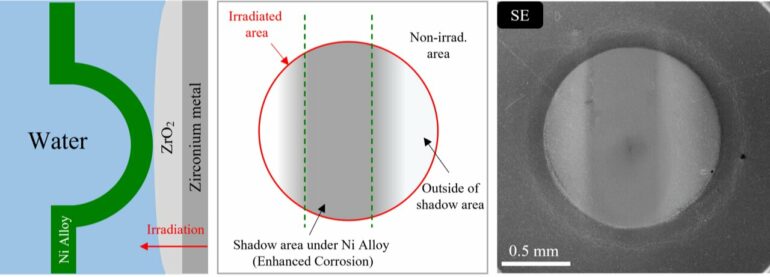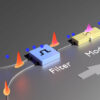Solutions to a 55-year-old problem in boiling water reactors—which represent a third of nuclear power reactors in the United States—are on the way now that the problem has been emulated with ion beams.
“Shadow corrosion” affects zirconium alloy (Zircaloy) fuel rods and fuel channels, creating images of nearby parts on their surface. The damage is a thicker layer of zirconium oxide—like rust on steel—almost as if the shadow of the neighboring part had been imprinted on the Zircaloy. It can create pinholes in the Zircaloy cladding around the fuel rods, requiring early replacement.
“It can also warp the channels between fuel assemblies, potentially preventing control blades regulating the reactor power,” said Gary Was, professor emeritus of nuclear engineering and radiological sciences and senior author of a new study in the Journal of Nuclear Materials.
While no meltdowns have occurred due to shadow corrosion, it drives up the cost of nuclear power because operators have to shut down reactors and waste fuel.
“The advantages of longer fuel life and a reduced risk of fuel failure include lower fuel cost, fewer outages, less radiation exposure for workers and lower maintenance cost—all of which lower the operating cost for the reactor,” Was said. “Outages, including down time for refueling, cost about $1 million per day.”
Research reactors can demonstrate shadow corrosion, but this method is expensive and time-consuming for studying the problem and its solutions. Nor could the shadow corrosion be repeated without radiation, just using a heated chamber filled with water.
“Until now, shadow corrosion was never reproduced in laboratory autoclave experiments because the simultaneous effect of irradiation was needed. What the University of Michigan experiment has shown was the simulation of the actual plant situation,” said Raul Rebak, a corrosion engineer at GE Research in Schenectady, New York, who was not involved with the research. GE is the world’s leading manufacturer of boiling water reactors.
Ion beams can test nuclear materials roughly a thousand times faster—and at a thousandth the cost—compared to research reactors. Ion beams produce more intense radiation, accelerating the aging of nuclear materials. However, most ion beam labs can’t reproduce all the conditions necessary for shadow corrosion.
A special high-temperature, high-pressure water cell that recreates the environment of a reactor core in the Michigan Ion Beam Laboratory was developed to enable this achievement. They call it a corrosion cell.
“This is a very unique setup,” said Peng Wang, U-M assistant research scientist in nuclear engineering and radiological sciences, lead researcher and first author of the paper. “We’re the first to successfully reproduce shadow corrosion outside of a reactor.”
Contact between Zircaloy fuel rods and the nickel alloy of the supporting structure creates a voltage that drives the corrosion reaction. But completing the circuit requires radiation to split water molecules, producing more reactive entities such as hydrogen peroxide. These form at the nickel alloy surface and then diffuse to the Zircaloy surface, accelerating its corrosion.
Wang demonstrated this with a flat nickel alloy sample running parallel to the Zircaloy sample in the corrosion cell—and with a curved sample that varied in its distance from the Zircaloy. The curved sample showed that the Zircaloy was more heavily oxidized where it was closer to the nickel alloy, the level of oxidation decreasing with distance.
“This result highlights the versatility and the high degree of control that accelerators and ions offer to create experiments with very well-controlled conditions that mimic the reactor environment.,” Was said. “You can study problems to the point where you understand the processes and then develop solutions.
Wang and Was have been working in collaboration with Framatome, a nuclear equipment company headquartered in Courbevoie, France, on solutions to shadow corrosion, expected to be announced next year. Karsten Nowotka, a group leader in fuel materials engineering at Framatome, contributed to this study, and Framatome funded the work.
More information:
Peng Wang et al, Reproducing shadow corrosion on Zircaloy-2 using in-situ proton irradiation, Journal of Nuclear Materials (2021). DOI: 10.1016/j.jnucmat.2021.153406
Provided by
University of Michigan
Citation:
Nuclear ‘shadow corrosion’ reproduced in the lab, paving way to longer fuel life (2021, December 20)



